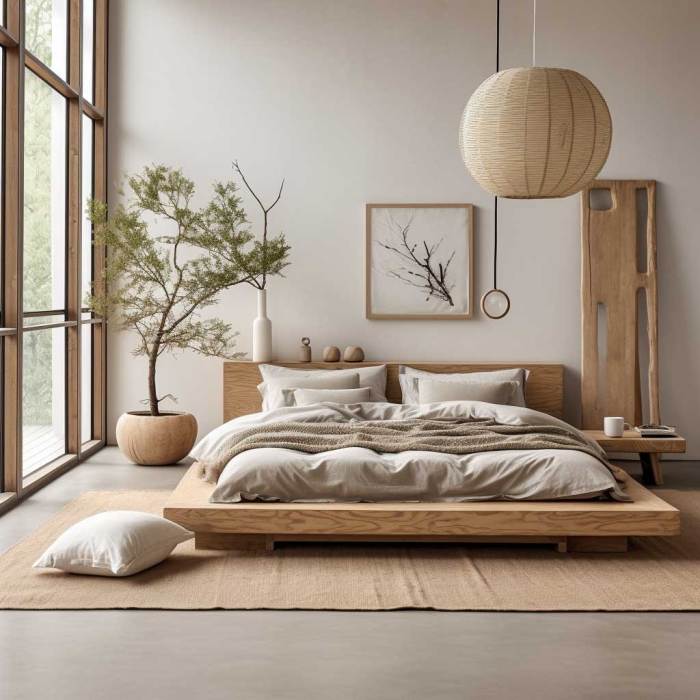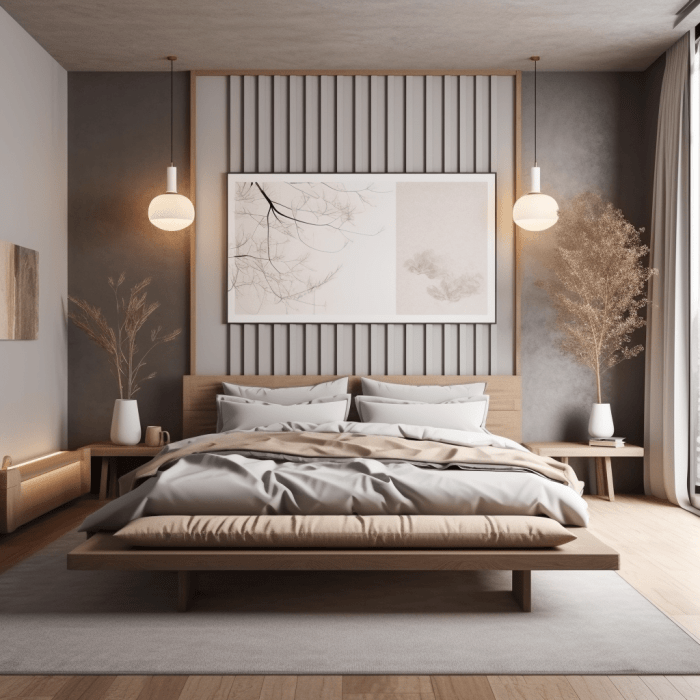Crafting a Serene Japandi Bedroom: A Fusion of Japanese and Scandinavian Design
Step into the world of Japandi bedroom, where the harmonious blend of Japanese and Scandinavian influences creates a tranquil and minimalist oasis in your home. This introduction sets the stage for a captivating exploration of the key elements that define this unique design style.
From the color palette to furniture choices, discover how to infuse your space with the perfect balance of simplicity and functionality for a peaceful retreat that reflects the essence of Japandi design.
Introduction to Japandi Bedroom
Japandi style in interior design is a fusion of Japanese minimalism and Scandinavian functionality, creating a harmonious and balanced aesthetic. A Japandi bedroom combines the simplicity and tranquility of Japanese design with the warmth and coziness of Scandinavian decor.
Key Characteristics of a Japandi Bedroom
- Minimalist Design: Clean lines, clutter-free spaces, and a focus on simplicity are key aspects of a Japandi bedroom.
- Natural Materials: Japandi bedrooms often feature wood, bamboo, and other natural materials to bring warmth and texture to the space.
- Neutral Color Palette: A harmonious blend of neutral tones like whites, grays, and earthy hues creates a calming atmosphere in a Japandi bedroom.
- Functional Furniture: Multi-functional furniture pieces with a minimalist design are characteristic of Japandi style, combining Japanese efficiency with Scandinavian practicality.
Influence of Japanese and Scandinavian Design Elements
The Japanese influence in a Japandi bedroom can be seen in the use of tatami mats, shoji screens, and traditional Japanese motifs like cherry blossoms. On the other hand, Scandinavian design elements such as hygge-inspired textiles, cozy blankets, and natural light play a significant role in creating a warm and inviting space.
Color Palette and Materials

In a Japandi bedroom, the color palette typically combines the calming and neutral tones of Scandinavian design with the earthy and muted hues of Japanese aesthetics. This fusion creates a harmonious and balanced atmosphere that promotes relaxation and tranquility.
Color Palette
- Neutrals like white, beige, and gray are commonly used as the base colors in a Japandi bedroom.
- Accents of soft pastels or muted blues and greens can be incorporated to add a touch of warmth and serenity.
- Earthy tones such as warm browns or soft terracotta may also be introduced to bring a sense of nature indoors.
Materials
- Wood is a predominant material in Japandi bedrooms, reflecting the natural elements found in both Japanese and Scandinavian design.
- Light-colored woods like oak, ash, or maple are often used for furniture pieces to maintain the light and airy feel of the room.
- Textured fabrics such as linen, cotton, or wool add depth and coziness to the space, enhancing the tactile experience.
- Metal accents in black or brass can be incorporated sparingly to provide contrast and a modern touch to the room.
Furniture and Layout

In a Japandi bedroom, the furniture follows a minimalistic approach, focusing on clean lines, functionality, and a sense of calmness. The choice of furniture pieces plays a crucial role in creating a harmonious and peaceful space.
Essential Furniture Pieces
- Bedframe: A low-profile bedframe made of natural materials like wood, with a simple and elegant design, is a staple in a Japandi bedroom.
- Nightstands: Pair of matching nightstands on each side of the bed, with clean lines and storage compartments, add to the functionality and aesthetic of the room.
- Wardrobe: A sleek and compact wardrobe with sliding doors or minimal handles helps in maintaining a clutter-free environment.
- Low Seating: Floor cushions or a small bench with cushions can provide additional seating without overcrowding the space.
- Shelving Units: Open shelving units made of natural materials allow for the display of decor items and keep the room organized.
Layout and Organization
The layout and organization of furniture in a Japandi bedroom are essential for achieving a sense of tranquility. Here are some key points to consider:
- Open Space: Leave ample space between furniture pieces to create a sense of openness and flow in the room.
- Functional Placement: Arrange furniture in a way that promotes functionality and ease of movement, ensuring that each piece serves a purpose.
- Minimal Decor: Keep the decor minimal and purposeful to maintain the simplicity and balance of the room.
- Natural Light: Position furniture to make the most of natural light, allowing it to illuminate the space and create a calming ambiance.
Decor and Accessories
In a Japandi bedroom, the decor and accessories play a crucial role in enhancing the overall aesthetic while maintaining a sense of simplicity and functionality.
Types of Decor and Accessories
Commonly seen decor and accessories in a Japandi bedroom include:
- Minimalistic artwork or wall decor with natural elements such as landscapes or botanical prints.
- Textiles like linen or cotton in neutral tones for bedding, curtains, and throw pillows.
- Handcrafted ceramics or pottery for small decor pieces like vases or trays.
- Bamboo or wooden accents in the form of picture frames, mirrors, or shelves.
Incorporating Nature into Decor
One way to bring elements of nature into the decor of a Japandi bedroom is by:
- Adding indoor plants such as bonsai trees, succulents, or bamboo to introduce greenery and promote a sense of tranquility.
- Using natural materials like rattan baskets, stone sculptures, or wooden sculptures to create a harmonious connection with the outdoors.
- Opting for earthy color palettes inspired by nature, such as soft greens, warm browns, and muted blues, to evoke a peaceful and serene atmosphere.
Balance of Simplicity and Functionality
When choosing decor and accessories for a Japandi bedroom, it is important to:
- Focus on selecting items that serve a purpose and contribute to the overall functionality of the space, rather than cluttering it with unnecessary decorations.
- Embrace minimalism by opting for quality over quantity, choosing a few statement pieces that reflect both Japanese and Scandinavian design principles.
- Ensure that each decor element not only enhances the visual appeal of the room but also serves a practical function, promoting a sense of calm and order.
Final Wrap-Up
In conclusion, a Japandi bedroom offers a refreshing take on modern interior design, combining the best of Japanese and Scandinavian aesthetics to create a space that is both stylish and serene. Embrace the elegance of minimalism and nature-inspired elements to transform your bedroom into a calming sanctuary that rejuvenates both body and soul.
General Inquiries
What sets Japandi style apart from other interior design trends?
Japandi style combines the simplicity and minimalism of Japanese design with the warmth and coziness of Scandinavian decor, creating a unique fusion that emphasizes clean lines, natural elements, and a sense of tranquility.
How can I incorporate natural elements into my Japandi bedroom?
You can bring nature indoors by incorporating wooden furniture, bamboo accents, stone decor, and plants to add texture, warmth, and a connection to the outdoors in your Japandi bedroom.
What is the significance of layout and organization in a Japandi bedroom?
Layout and organization play a crucial role in creating a peaceful Japandi bedroom. Embrace a minimalist approach with a focus on functionality, ensuring that each piece of furniture and decor serves a purpose while maintaining a sense of balance and harmony in the space.




